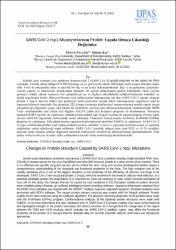| dc.contributor.author | Akbulut, Ekrem | |
| dc.date.accessioned | 2022-03-14T08:47:13Z | |
| dc.date.available | 2022-03-14T08:47:13Z | |
| dc.date.issued | 2020 | en_US |
| dc.identifier.citation | Akbulut, E., & Bülent, K. A. R. (2020). SARS CoV-2 nsp1 Mutasyonlarının Protein Yapıda Ortaya Çıkardığı Değişimler. International Journal of Pure and Applied Sciences, 6(2), 68-76. | en_US |
| dc.identifier.uri | https://doi.org/10.29132/ijpas.793377 | |
| dc.identifier.uri | https://hdl.handle.net/20.500.12899/616 | |
| dc.description.abstract | Şiddetli akut solunum yolu sendromu koronavirüsü 2 (SARS CoV-2) pozitif polariteli ve tek iplikli bir RNA virüsüdür. Virüsün sebep olduğu COVID19 hastalığı on ay gibi kısa bir sürede 900 binden fazla insanın ölümüne neden oldu. Virüs ile mücadelede etkin ve spesifik bir ilaç ve aşı henüz bulunmamaktadır. İlaç ve aşı geliştirme çalışmaları virüsün yapısal ve fonksiyonel özelliklerinin kapsamlı bir şekilde anlaşılmasını gerekli kılmaktadır. Hızlı yayılım gösteren virüsün yüksek mutasyon hızı geliştirilecek aşı ve ilaçların etkinliklerini sürdürebilmelerinin önündeki en büyük engellerden biridir. Hücresel boyutta viral enfeksiyonun başlangıcında yer alan SARS CoV-2 yapısal olmayan protein 1 (nsp1) önleyici tedavi için potansiyel hedef proteindir. Konak hücre translasyonunu engelleyen nsp1’in yapısının bilinmesi önemlidir. Bu çalışmada 222 Avrupa izolatında görülen nsp1 mutasyonlarının protein yapıda ortaya çıkarabileceği değişimler yapay zekâ tabanlı bir modelleme yazılımı olan trRosetta kullanılarak modellenmiştir. NCBI Virüs veritabanından elde edilen dizi bilgileri MAFFT çoklu dizi hizalama programı ile hizalanmıştır. Mutasyon analizleri RDP4 yazılımı ile yapılmıştır. Mutant protein primer yapı MegaX yazılımı ile oluşturulmuştur. Protein kalite skorları QMEAN algoritması kullanılarak analiz edilmiştir. Proteinleri fizikokimyasla özellikleri ProtParam ExPAsy programı ile yapılmıştır. Elde edilen protein yapıların konformasyonel analizleri PyMOL ile yapılmıştır. SARS CoV-2 Avrupa izolatlarında görülen nsp1 mutasyonlarının protein sekonder ve tersiyer yapısında konformasyonel ve topolojik değişimlere neden olabileceği tespit edilmiştir. SARS CoV-2 katalitik bölgeyi içine alan P153 ve N178 rezidüleri arasında kalan bölgede görülen değişimin proteinin fonksiyonel özelliklerini etkileyebileceği düşünülmektedir. Elde edilen verilerin önleyici ve tedavi edici yaklaşımlara önemli veriler sunabileceği düşünülmektedir. | en_US |
| dc.description.abstract | Severe acute respiratory syndrome coronavirus 2 (SARS CoV-2) is a positive-polarity single-stranded RNA virus.
COVID19 disease caused by the virus has killed more than 900 thousand people in a short period of ten months. There
is no effective and specific drug and vaccine yet to combat the virus. Drug and vaccine development studies require a
comprehensive understanding of the structural and functional properties of the virus. The high mutation rate of the
rapidly spreading virus is one of the biggest obstacles to the continuity of the efficiency of vaccines and drugs to be
developed. SARS CoV-2 non-structural protein 1 (nsp1), which is involved in the onset of cellular viral infection, is a
potential candidate protein for prophylaxis. It is important to know the structure of nsp1, which prevents translation of
host cell. In this study, the changes that can be caused by nsp1 mutations in 222 European isolates in protein structure
were modeled using trRosetta, an artificial intelligence-based modeling software. Sequence information obtained from
the NCBI Virus database was aligned with the MAFFT multiple sequence alignment program. Mutation analyzes were
performed with RDP4 software. The mutant protein primary construct was created with the MegaX software. Protein
quality scores were analyzed using the QMEAN algorithm. The physical chemistry properties of the proteins were made
with the ProtParam ExPAsy program. Conformational analyzes of the obtained protein structures were made with
PyMOL. It has been determined that nsp1 mutations seen in SARS CoV-2 European isolates may cause conformational
and topological changes in the protein secondary and tertiary structure. It is thought that the change seen in the region
between the P153 and N178 residues, which includes the SARS CoV-2 catalytic region, may affect the functional
properties of the protein. It is thought that the obtained data can provide important data for preventive and therapeutic
approaches. | en_US |
| dc.language.iso | tr | en_US |
| dc.publisher | Munzur Üniversitesi | en_US |
| dc.rights | info:eu-repo/semantics/openAccess | en_US |
| dc.subject | COVID19, | en_US |
| dc.subject | homoloji model, | en_US |
| dc.subject | nsp1, | en_US |
| dc.subject | SARS CoV-2 | en_US |
| dc.title | SARS CoV-2 nsp1 Mutasyonlarının Protein Yapıda Ortaya Çıkardığı Değişimler | en_US |
| dc.title.alternative | Changes in Protein Structure Caused by SARS CoV-2 nsp1 Mutations | en_US |
| dc.type | Article | en_US |
| dc.authorid | 0000-0002-7526-9835 | en_US |
| dc.department | MTÖ Üniversitesi, Ziraat Fakültesi, Zootekni Bölümü | en_US |
| dc.identifier.doi | 10.29132/ijpas.793377 | |
| dc.identifier.volume | 6 | en_US |
| dc.identifier.issue | 2 | en_US |
| dc.identifier.startpage | 68 | en_US |
| dc.identifier.endpage | 76 | en_US |
| dc.relation.publicationcategory | Makale - Uluslararası Hakemli Dergi - Kurum Öğretim Elemanı | en_US |
| dc.indekslendigikaynak | TR-Dizin | en_US |


















